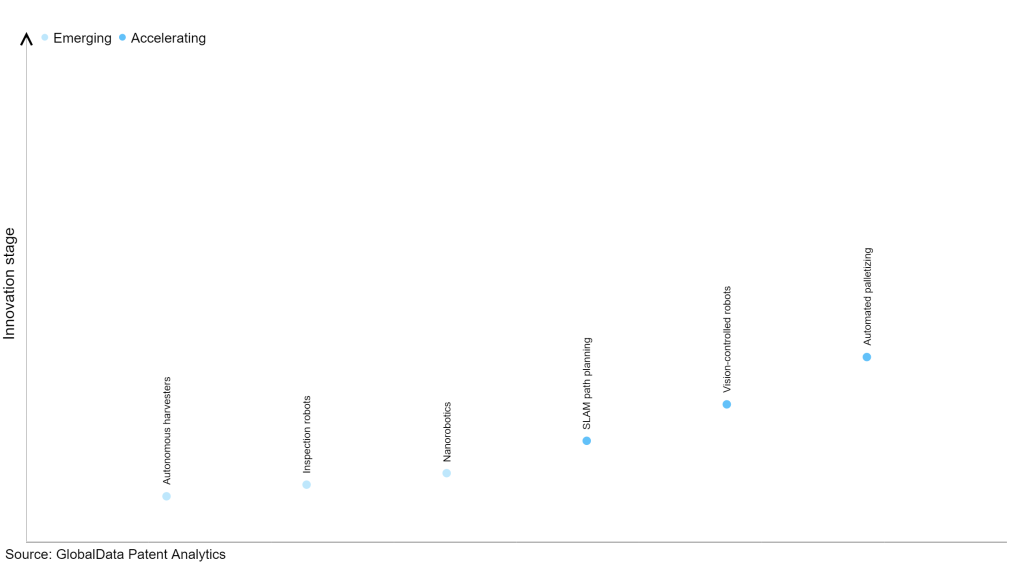The technology industry continues to be a hotbed of innovation, with activity driven by the progress in robotics, machine learning, artificial intelligence, and sensor technologies, and growing importance of technologies such as nanomaterials, nanofabrication techniques, molecular self-assembly, and smart sensors and actuators. In the last three years alone, there have been over 1.5 million patents filed and granted in the technology industry, according to GlobalData’s report on Innovation in Robotics: Nanorobotics. Buy the report here.
However, not all innovations are equal and nor do they follow a constant upward trend. Instead, their evolution takes the form of an S-shaped curve that reflects their typical lifecycle from early emergence to accelerating adoption, before finally stabilising and reaching maturity.
Identifying where a particular innovation is on this journey, especially those that are in the emerging and accelerating stages, is essential for understanding their current level of adoption and the likely future trajectory and impact they will have.
185+ innovations will shape the technology industry
According to GlobalData’s Technology Foresights, which plots the S-curve for the technology industry using innovation intensity models built on over 1.6 million patents, there are 185+ innovation areas that will shape the future of the industry.
Within the emerging innovation stage, autonomous harvesters, inspection robots and nanorobotics are disruptive technologies that are in the early stages of application and should be tracked closely. SLAM path planning, vision-controlled robots, and automated palletizing are some of the accelerating innovation areas, where adoption has been steadily increasing.
Innovation S-curve for robotics in the technology industry

Nanorobotics is a key innovation area in robotics
Nanorobotics is a branch of nanotechnology that focuses on creating and advancing tiny robots at the nanoscale. These robots are purpose-built for carrying out precise operations or engaging with nanomaterials and other nanoscale devices. Nanorobotics holds immense transformative potential across various domains, including science, medicine, and technology.
GlobalData’s analysis also uncovers the companies at the forefront of each innovation area and assesses the potential reach and impact of their patenting activity across different applications and geographies. According to GlobalData, there are 3 companies, spanning technology vendors, established technology companies, and up-and-coming start-ups engaged in the development and application of nanorobotics.
Key players in nanorobotics – a disruptive innovation in the technology industry
‘Application diversity’ measures the number of different applications identified for each relevant patent and broadly splits companies into either ‘niche’ or ‘diversified’ innovators.
‘Geographic reach’ refers to the number of different countries each relevant patent is registered in and reflects the breadth of geographic application intended, ranging from ‘global’ to ‘local’.
Patent volumes related to nanorobotics
Source: GlobalData Patent Analytics
Gilead Sciences is one of the leading patent filers in nanorobotics. The company’s patents are related to a bi-specific antibody or antibody fragment having at least one arm that is reactive against a targeted tissue and at least one other arm that is reactive against a linker moiety.
The linker moiety encompasses a hapten to which antibodies have been prepared. The antigenic linker is conjugated to one or more therapeutic or diagnostic agents or enzymes. The invention provides methods for producing and using the bi-specific antibodies or antibody fragments.
Other prominent patent filers in the space include Koninklijke Philips and Bristol-Myers Squibb.
By geographic reach, Nitto Denko leads the pack, followed by Eli Lilly and Ono Pharmaceutical. In terms of application diversity, Vascular Biogenics holds the top position, followed by Bristol-Myers Squibb and Supernus Pharmaceuticals.
Nanorobotics can offer new possibilities for improving human health, addressing environmental challenges, advancing technology, and expanding understanding of the nanoworld. The significance of nanorobotics lies in its potential to revolutionise fields such as medicine, materials science, environmental science, manufacturing, and scientific research.
To further understand how robotics is disrupting the technology industry, access GlobalData’s latest thematic research report on Robotics – Thematic Research Report.
Data Insights
From

The gold standard of business intelligence.
Blending expert knowledge with cutting-edge technology, GlobalData’s unrivalled proprietary data will enable you to decode what’s happening in your market. You can make better informed decisions and gain a future-proof advantage over your competitors.







